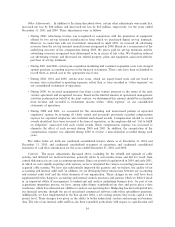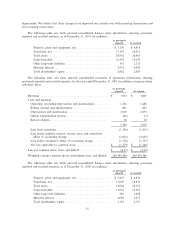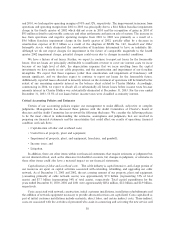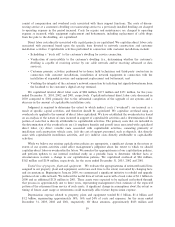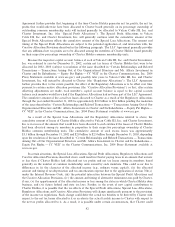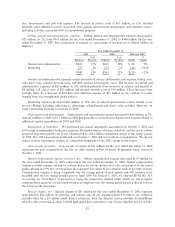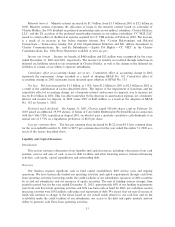Charter 2003 Annual Report Download - page 45
Download and view the complete annual report
Please find page 45 of the 2003 Charter annual report below. You can navigate through the pages in the report by either clicking on the pages listed below, or by using the keyword search tool below to find specific information within the annual report.receive future allocations of taxable income in excess of its currently allocated tax deductions and available tax
loss carryforwards.
In addition, under their exchange agreement with Charter, Vulcan Cable III, Inc. and Charter
Investment, Inc. may exchange some or all of their membership units in Charter Holdco for Charter's Class B
common stock, be merged with Charter, or be acquired by Charter in a non-taxable reorganization. If such an
exchange were to take place prior to the date that the Special ProÑt Allocation provisions had fully oÅset the
Special Loss Allocations, Vulcan Cable III, Inc. and Charter Investment, Inc. could elect to cause Charter
Holdco to make the remaining Special ProÑt Allocations to Vulcan Cable III, Inc. and Charter Investment,
Inc. immediately prior to the consummation of the exchange. In the event Vulcan Cable III, Inc. and Charter
Investment, Inc. choose not to make such election or to the extent such allocations are not possible, Charter
would then be allocated tax proÑts attributable to the membership units received in such exchange pursuant to
the Special ProÑt Allocation provisions. Mr. Allen has generally agreed to reimburse Charter for any
incremental income taxes that Charter would owe as a result of such an exchange and any resulting future
Special ProÑt Allocations to Charter.
As of December 31, 2003 and 2002, we have recorded net deferred income tax liabilities of $417 million
and $519 million, respectively. Additionally, as of December 31, 2003 and 2002, we have deferred tax assets of
$1.7 billion and $1.5 billion, respectively, which primarily relate to Ñnancial and tax losses allocated to Charter
from Charter Holdco. We are required to record a valuation allowance when it is more likely than not that
some portion or all of the deferred income tax assets will not be realized. Given the uncertainty surrounding
our ability to utilize our deferred tax assets, these items have been oÅset with a corresponding valuation
allowance of $1.3 billion and $1.4 billion at December 31, 2003 and 2002, respectively.
We are currently under examination by the Internal Revenue Service for the tax years ending
December 31, 1999 and 2000. Management does not expect the results of this examination to have a material
adverse eÅect on our consolidated Ñnancial condition, results of operations or our liquidity, including our
ability to comply with our debt covenants.
Litigation. As described in the ""Legal Proceedings'' section of the Charter Communications, Inc. 2003
Annual Report on Form 10-K available at www.sec.gov, numerous allegations have been made against us.
These legal contingencies have a high degree of uncertainty. No reserves have been established for these
matters because we are unable to predict the outcome. When a contingency becomes estimable and probable,
a reserve is established. We have established reserves for certain other matters. If any of the litigation matters
described are resolved unfavorably, such resolution could have a material adverse eÅect on our consolidated
Ñnancial condition, results of operations or our liquidity, including our ability to comply with our debt
covenants.
43



